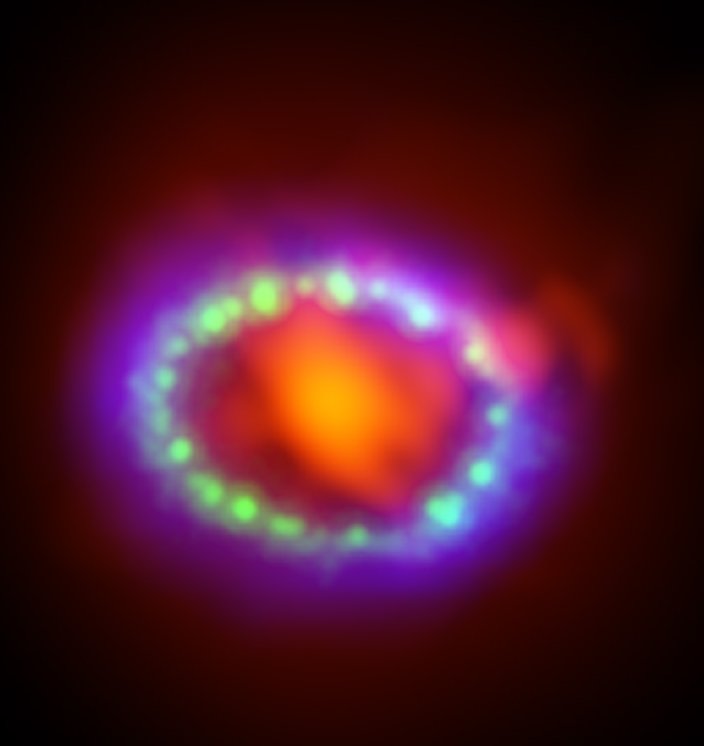New structures within iconic supernova 1987A

NASA’s James Webb Space Telescope has begun the study of one of the most renowned supernovae, SN 1987A (Supernova 1987A). Located 168,000 light-years away in the Large Magellanic Cloud, SN 1987A has been a target of intense observations at wavelengths ranging from gamma rays to radio for nearly 40 years, since its discovery in February of 1987. New observations by Webb’s NIRCam (Near-Infrared Camera) provide a crucial clue to our understanding of how a supernova develops over time to shape its remnant.

Credits: NASA, ESA, CSA, M. Matsuura (Cardiff University), R. Arendt (NASA’s Goddard Spaceflight Center & University of Maryland, Baltimore County), C. Fransson (Stockholm University), and J. Larsson (KTH Royal Institute of Technology). Image Processing: A. Pagan
This image reveals a central structure like a keyhole. This center is packed with clumpy gas and dust ejected by the supernova explosion. The dust is so dense that even near-infrared light that Webb detects can’t penetrate it, shaping the dark “hole” in the keyhole.
A bright, equatorial ring surrounds the inner keyhole, forming a band around the waist that connects two faint arms of hourglass-shaped outer rings. The equatorial ring, formed from material ejected tens of thousands of years before the supernova explosion, contains bright hot spots, which appeared as the supernova’s shock wave hit the ring. Now spots are found even exterior to the ring, with diffuse emission surrounding it. These are the locations of supernova shocks hitting more exterior material.
While these structures have been observed to varying degrees by NASA’s Hubble and Spitzer Space Telescopes and Chandra X-ray Observatory, the unparalleled sensitivity and spatial resolution of Webb revealed a new feature in this supernova remnant – small crescent-like structures. These crescents are thought to be a part of the outer layers of gas shot out from the supernova explosion. Their brightness may be an indication of limb brightening, an optical phenomenon that results from viewing the expanding material in three dimensions. In other words, our viewing angle makes it appear that there is more material in these two crescents than there actually may be.
The high resolution of these images is also noteworthy. Before Webb, the now-retired Spitzer telescope observed this supernova in infrared throughout its entire lifespan, yielding key data about how its emissions evolved over time. However, it was never able to observe the supernova with such clarity and detail.
Despite the decades of study since the supernova’s initial discovery, there are several mysteries that remain, particularly surrounding the neutron star that should have been formed in the aftermath of the supernova explosion. Like Spitzer, Webb will continue to observe the supernova over time. Its NIRSpec (Near-Infrared Spectrograph) and MIRI (Mid-Infrared Instrument) instruments will offer astronomers the ability to capture new, high-fidelity infrared data over time and gain new insights into the newly identified crescent structures. Further, Webb will continue to collaborate with Hubble, Chandra, and other observatories to provide new insights into the past and future of this legendary supernova.